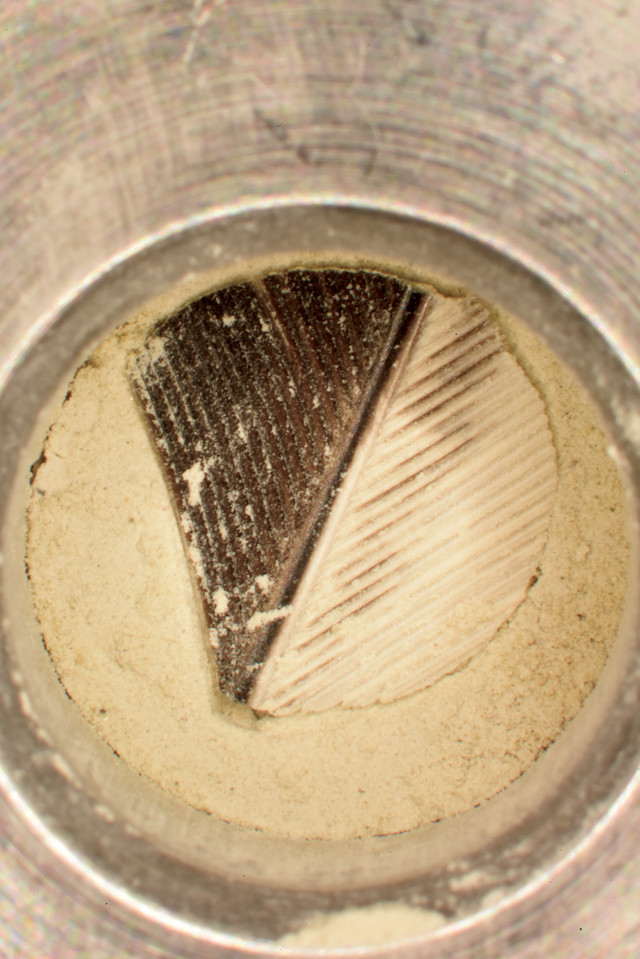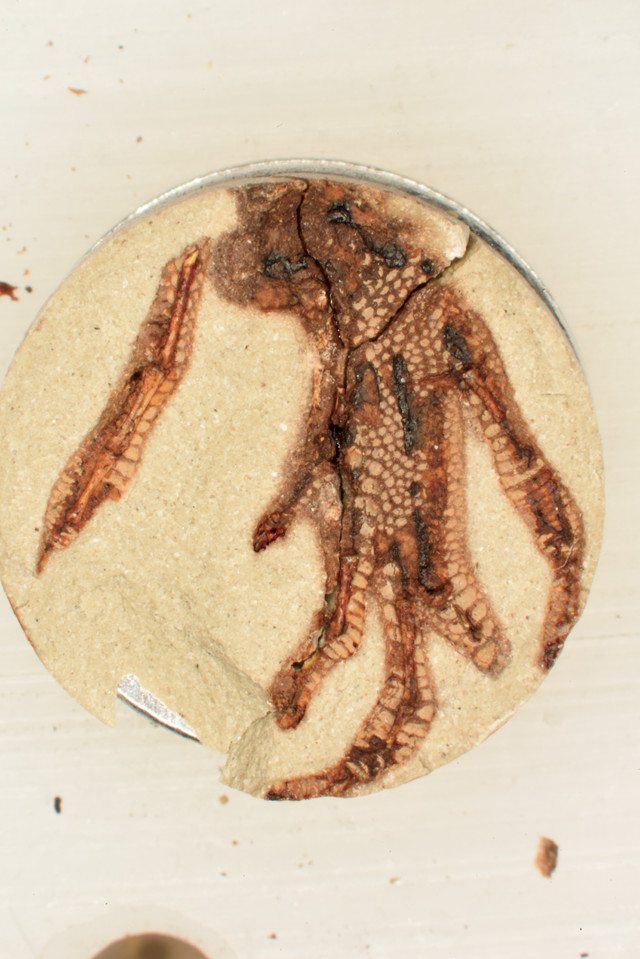
by Mary Caperton Morton Tuesday, October 16, 2018

The method to simulate fossilization can also be used onfeathers. Credit: The Field Museum.

A new method to simulate fossilization can be used on much larger samples than previous methods, including whole lizard heads and feet. Credit: The Field Museum.
Most fossils are millions of years in the making, but a new technique is allowing scientists to simulate the process of fossilization in about 24 hours. The laboratory-based method, described in a study published in the journal Palaeontology, sheds light on how exceptionally preserved fossils form generally over geologic time and may provide custom samples for research projects investigating specific conditions under which certain fossils formed.
Fossil simulation is “not making or replicating fossils. [It is] experimentally degrading modern tissues,” says Maria McNamara, a paleobiologist at the University College Cork in Ireland, who was not involved in the new study but has separately investigated how to simulate fossilization. “But in terms of their morphological and chemical features, simulated fossils are very similar to actual fossils.”
Scientists have been attempting to simulate fossilization in lab settings for the last 30 years, usually by subjecting samples to high temperature and pressure in a process known as maturation. Results have been mixed, however. Maturation experiments are typically conducted by placing a sample inside a small sealed container, which traps biomolecules that would normally be lost in the fossilization process. “When you open the capsules used in traditional maturation, this really stinky goo spills out, which is essentially broken down, degraded proteins,” says Evan Saitta, a paleontologist at the Field Museum of Natural History in Chicago and lead author of the new study. “Since we don’t see gooey fossils [in nature], that’s a sign that those simulations are not getting it quite right.”
During true fossilization, most specimens are encased in sediment that holds the fossil in place, while pore spaces allow mobilized fluids and gases to leach away from the sample. “Fossilization often occurs in a fairly open system, where materials can come and go throughout the process,” Saitta says. To more closely mimic these conditions, Saitta and colleagues first packed samples of lizard heads and feet, bird feathers, leaves, and arthropod cuticles into clay tablets using a hydraulic press. They then heated the tablets inside sealed metal tubes to 210 degrees Celsius at a pressure of about 24 megapascals (roughly 240 times atmospheric pressure at sea level). The sealed chambers were equipped with air lines, which the researchers used to change the pressure.
“When we cracked open the tablets, we were absolutely thrilled,” Saitta says. The specimens “looked very much like real fossils at the macroscopic level, consisting of darkened, browned bones surrounded by a dark halo left by the degraded soft tissues. The feathers we tested closely resembled exceptionally preserved fossil feathers found in China.” The true-to-form appearance of the feathers also held up under a scanning electron microscope, which clearly showed melanosomes — the organelles responsible for pigmentation of feathers that are used in paleo-color reconstructions — resting on the surface of the sediment. “The melanosomes appear very much the same as we see in fossil feathers,” Saitta says, suggesting the new method offers “a fairly true simulation.”
“This is an interesting study, and the [researchers’] method has potential in the realm of experimental paleontology,” McNamara says. One advance it represents is in the size of the samples being used, she says. “Their samples are up to 19 millimeters across, whereas most maturation techniques are applied to samples around 5 millimeters. By using bigger chunks of tissue, it may be easier to conduct some kinds of experiments [on the simulated fossils].”
The fossils are also “easily manipulated and very stable. You can treat and store them in the same way that you treat and store [real] fossils,” Saitta says. The method is not yet perfect, however, he notes. The team is currently tinkering with improvements, such as adding unidirectional compaction during the pressure-cooking phase to more closely mimic true fossilization conditions in which pressure is mainly applied from above by overlying rock and sediments. “We’d also like to incorporate flowing water to the process at some point. Water flows through sediments underground, which can lead to a loss of unstable biomolecules and greater cementation of sediments.”
Real fossils will always be the bread and butter of paleontology, but simulated fossils have their place, Saitta says. “Paleontology cannot divorce itself from actual fossils — they are the true recordkeepers of evolution — but if we find a fossil in the future with a unique form of preservation, then we can go to our experimental platform and begin to play around with it to see if we can mimic those conditions,” he says. “There’s a lot of potential with these samples. It’ll be interesting to see all the ways that [other researchers] can devise to experiment with them.”
© 2008-2021. All rights reserved. Any copying, redistribution or retransmission of any of the contents of this service without the expressed written permission of the American Geosciences Institute is expressly prohibited. Click here for all copyright requests.